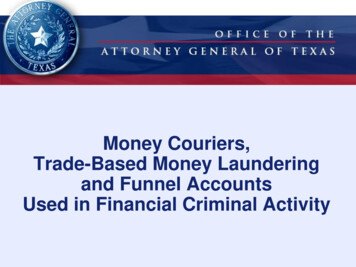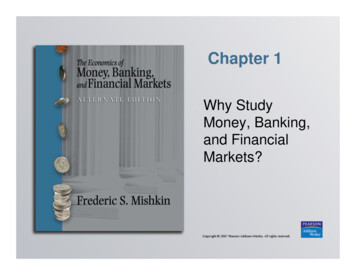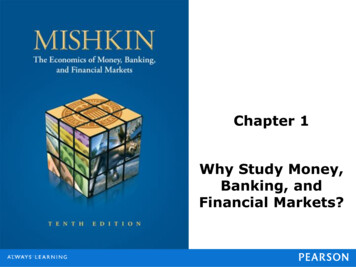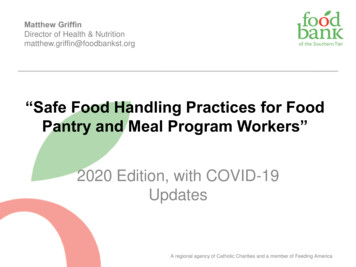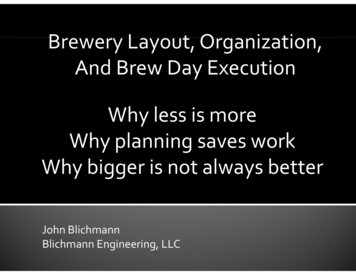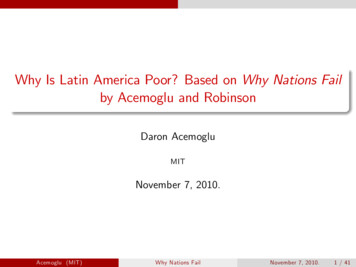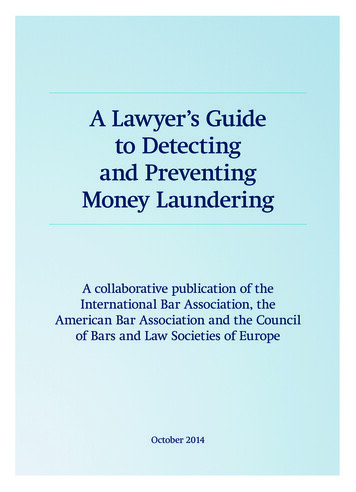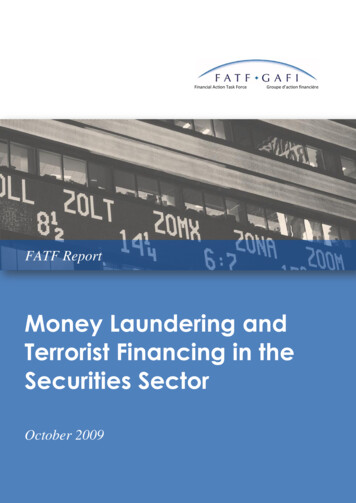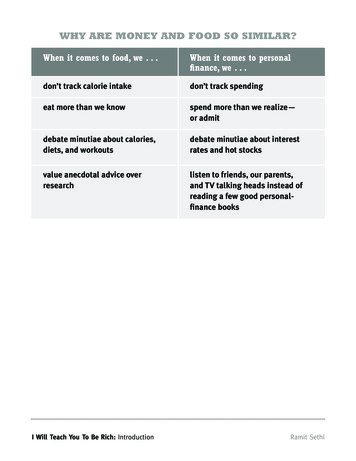
Transcription
WHY ARE MONEY AND FOOD SO SIMILAR?When it comes to food, we . . .When it comes to personalfinance, we . . .don’t track calorie intakedon’t track spendingeat more than we knowspend more than we realize—or admitdebate minutiae about calories,diets, and workoutsdebate minutiae about interestrates and hot stocksvalue anecdotal advice overresearchlisten to friends, our parents,and TV talking heads instead ofreading a few good personalfinance booksI Will Teach You To Be Rich: IntroductionRamit Sethi
HOW TO MAKE 50,000 MORE THAN YOUR FRIENDS(WITH LESS WORK)Smart SallyDumb DanWhen beginning toinvest, the person is . . .25 years old35 years oldEach person invests 100/month for . . .10 years30 years 200,061.Voilà—the valueof starting early 149,036. Even thoughhe invested for threetimes as long, he’sbehind by 80,000With an 8 percent rateof return, at age 65,their accounts areworth . . .I Will Teach You To Be Rich: IntroductionRamit Sethi
CREDIT SCORE VS. CREDIT REPORTWhat your credit score isbased on:What your credit reportincludes:35% payment history(How reliable you are.Late payments hurt you.)n Basic identification information30% amounts owed(How much you owe and howmuch credit you have available,or your credit utilization rate.)n A list of all your credit accounts15% length of history(How long you’ve had credit.)n Your credit history, or whom10% new credit(Older accounts are betterbecause they show you’rereliable.)n Amount of loans10% types of credit(For example, credit cards,student loans. Varied is better.)n Credit inquiries, or who elseGet your credit score atwww.myfico.com for about 15.Get your free credit report once ayear at www.annualcreditreport.com.I Will Teach You To Be Rich: Chapter 1you’ve paid, how consistently,and any late paymentshas requested your credit(like other lenders)Ramit Sethi
HOW CREDIT SCORES AFFECT WHAT YOU PAYOn a 200,00030-year mortgage,if your FICO scoreis . . . . . your APR*(interest rate) willbe . . . . . with interest,you’ll pay a totalof . . .760–850(best range)4.384% 359,867700–7594.606% 369,364680–6994.783% 377,021660–6794.997% 386,381640–6595.427% 405,515620–639(worst range)5.973% 430,427*APR calculated in January 2009.I Will Teach You To Be Rich: Chapter 1Ramit Sethi
GUESS HOW MUCH AN iPOD COSTS IF YOUFINANCE IT WITH A CREDIT CARD?One of the biggest problems with credit cards is the hidden cost ofusing them. It may be incredibly convenient to swipe your card atevery retailer, but if you don’t pay your bill the same month, you’ll end upowing way more than you realize. Take, for instance, an iPod. It looks likeit costs 250, but if you buy it using a credit card with the average 14% APRand a 4% minimum payment, and then only pay the minimum each month,you’ll be out almost 20 percent more in total.Let’s say you buythis . . .Paying minimumpayments, it willtake this long topay it off . . .You’ll paythis much ininterest . . . 250 iPod2 years 6 months 47 1,500 computer7 years 9 months 562 10,000 furniture13 years 3 months 4,062If you paid only the minimum monthly balance on your 10,000 purchase,it would take you more than 13 years and cost you more than 4,000 ininterest alone. Remember, this doesn’t even factor in your “opportunitycost”: Instead of paying off a 10,000 sofa for 13 years, if you’d invested thesame amount and earned 8%, it would’ve turned into about 27,000! Trycalculating how much your own purchases really cost at www.bankrate.com/brm/calc/minpayment.aspI Will Teach You To Be Rich: Chapter 1Ramit Sethi
DUMB DAN VS. SMART SALLY:PAYING OFF 5,000 CREDIT CARD DEBT AT 14% APRDumb Dan pays the minimum monthly paymentHis monthlypayment is . . .Paying minimumpayments, it will takethis long to pay off . . .Total amount ofinterest he pays is . . . 2002 years, 8 months 1,313.96Smart Sally pays twice the minimum monthly paymentHer monthlypayment is . . .Paying twice theminimum payments, itwill take this long topay off . . .Total amount ofinterest she pays is . 40014 months 436.46I Will Teach You To Be Rich: Chapter 1Ramit Sethi
PRIORITIZING YOUR DEBTHow itworksWhy itworksSnowball method: lowestbalance firstStandard method:highest APR firstPay the minimum on allcards, but pay more onthe card with the lowestbalance. Once you pay offthe first card, repeat withthe next-lowest balance.Pay the minimum on allcards, but pay more onthe card with the highestinterest. Once you payoff the first card, repeatwith the next-highest-APRcard.This is all about psychologyand small wins. Once youpay off the first card, you’remore motivated to pay offthe next one.Mathematically, you wantto pay off the credit cardthat’s costing you themost first.I Will Teach You To Be Rich: Chapter 1Ramit Sethi
HOW MUCH YOU EARN ATONLINE BANKS VS. BIG BANKSIf you saved . . .Online highinterest banks:At 3% interest,you’d earn . . .Big uselessbanks:At 0.5% interest,you’d earn . . . 1,000 30 per year 5 per year 5,000 150 per year 25 per year 10,000 300 per year 50 per year 25,000 750 per year 125 per year 50,000 1,500 per year 250 per yearI Will Teach You To Be Rich: Chapter 2Ramit Sethi
OLDER PEOPLE REGRET NOT INVESTINGI’m not a crotchety old man yet, but when I see these numbers, it’stempting to run around with a cane and a vodka tonic in hand, screamingat young people. Not only do we fail to invest our money, but we don’t evenknow why it’s important!Age ofemployee18–25Percentagewhoparticipatein a 401(k)Percentageof paytheyContribute31.3%5.6%Medianbalanceof their401(k)My comment 1,280Too busy watchingThe Hills.These peoplehave realizedthat perhapssaving money isimportant.26–4163.1%7.2% 14,73042 andup72.0%8.3% 44,330These older folksare wishing theycould go backin time and beatthemselves for notsaving more, likeBiff in Back to theFuture II.Source: Hewitt and Associates As.aspx)I Will Teach You To Be Rich: Chapter 3Ramit Sethi
A FIFTH OF YOUNG PEOPLE THINK THEY’LL GETRICH THROUGH THE LOTTERYPercentage ofyoung people . . . . . Who believethey’ll get rich . . .My comment21%By winning thelotteryI hate you.11%Through aninheritanceI hate you.3%Via an insurancesettlementI Will Teach You To Be Rich: Chapter 3How about theinsurance of doingsome actual workto learn about yourmoney?Ramit Sethi
INVEST NOW . . .YOU’RE NOT GETTING ANY YOUNGERWhat if you had started investing 10 per week five years ago,receiving an average 8 percent return? Guess how much you’dhave? It turns out that by now, you’d have thousands of dollars—all frominvesting a little more than 1 per day. Think about that 10 a week—wheredid it go, anyway? If you’re like most people, it probably slipped throughyour fingers on random things like cab rides and lunches. Despite wild ridesin the stock market, with a long term perspective, the best thing you can dois start investing early.If you investthis much perweek . . .After 1 year,you’ll have . . .After 5 years,you’ll have . . .After 10 years,you’ll have . . . 10 562 3,295 8,136 20 1,123 6,589 16,271 50 2,808 16,473 40,678I Will Teach You To Be Rich: Chapter 3Ramit Sethi
HOW A 401(K) utemployermatch25 5,000 5,000 5,214 10,42830 5,000 5,000 38,251 76,50135 5,000 5,000 86,792 173,58540 5,000 5,000 158,116 316,23145 5,000 5,000 262,913 525,82650 5,000 5,000 416,895 833,79055 5,000 5,000 643,145 1,286,29060 5,000 5,000 975,581 1,951,16165 5,000 5,000 1,350,762 2,701,525I Will Teach You To Be Rich: Chapter 3BalancewithemployermatchRamit Sethi
RETIREMENT VS. NONRETIREMENT ACCOUNTEARNINGS OVER TIME(Assumes a 25% tax rate, 5,000 annual contribution ( 3,750 after taxes)over 40 years, 8 percent rate of return)1,500,000 1,398,9051,200,000 1,049,178900,000600,000 615,178300,0000Regular TaxableAccountI Will Teach You To Be Rich: Chapter 3401(k) Before Tax401(k) After TaxRamit Sethi
HOW MUCH WILL A ROTH IRA SAVE YOU?Assumptions: 25 percent tax rate (now and at retirement), 8 percentannual rate of return, yearly contribution of 5,000 (that’s 417/month).Notice how much taxes eat out of your returns.Roth IRARegular taxableinvestmentaccountDoingnothing5 years 31,680 29,877010 years 78,227 69,858015 years 146,621 123,363020 years 247,115 194,974025 years 394,772 290,782030 years 611,729 419,1180I Will Teach You To Be Rich: Chapter 3Ramit Sethi
RECOMMENDED DISCOUNT BROKERAGESBrokerage nameMinimumto open aRoth IRAThings to knowVanguardwww.vanguard.com,(877) 662-7447 3,000Vanguard is great because oftheir low-cost funds. But theydon’t waive their minimums,even with automatic investing.If you want a Vanguard accountbut don’t have 3,000, see page106 to set it as a savings goal.T. Rowe Pricewww.troweprice.com,(800) 541-6066 1,000Minimum is waived with 50automatic monthly contribution.Great low-cost funds.Schwabwww.schwab.com,(866) 855-9102 1,000Minimum is waived with 100 automatic monthlycontribution. If you set up ahigh-interest Schwab checkingaccount from page 62, Schwabwill automatically link abrokerage account to it. Handyfor automatic investing.I Will Teach You To Be Rich: Chapter 3Ramit Sethi
CHEAP PEOPLE VS. FRUGAL PEOPLECheapFrugalCheap people care about the costof something.Frugal people care about the valueof something.Cheap people try to get the lowestprice on everything.Frugal people try to get the lowestprice on most things, but arewilling to spend on items theyreally care about.Cheap people’s cheapness affectsthose around them.Frugal people’s frugality affectsonly them.Cheap people are inconsiderate.For example, when getting a mealwith other people, if their foodcosts 7.95, they’ll put in 8,knowing very well that tax and tipmean it’s closer to 11.Frugal people know they have topick and choose where they spendtheir money. If they can spendonly 10 on lunch, they’ll orderwater instead of Coke.Cheap people make youuncomfortable because of theway they treat others.Frugal people make you feeluncomfortable because yourealize you could be doing betterwith your money.Cheap people keep a running tallyof how much their friends, family,and coworkers owe them.Some frugal people do this, too,but certainly not all.Because of the fear of even oneperson suggesting they spent toomuch on something, cheap peopleare not always honest about whatthey spend.Neither are frugal people.Cheap people are unreasonableand cannot understand why theycan’t get something for free.Sometimes this is an act, butsometimes it’s not.Frugal people will try as hardas cheap people to get a deal,but they understand that it’s adance, and in the end, they knowthey don’t intrinsically deserve aspecial deal.Cheap people think short term.Frugal people think long term.I Will Teach You To Be Rich: Chapter 4Ramit Sethi
CATEGORIES OF SPENDINGFixed costsRent, utilities, debt, etc.50–60% of take-homepayInvestments10%401(k), Roth IRASavings5–10%Vacations, gifts, house down payment,unexpected expensesGuilt-free spending money20–35%Dining out, drinking, movies, clothes, shoesI Will Teach You To Be Rich: Chapter 4Ramit Sethi
Eating outTaxisBooksTimes per month1285Amount per event 23 9 17I Will Teach You To Be Rich: Chapter 4Ramit Sethi
tt ingupCoGeAmount of EffortsetTHE CURVE OF DOING MORE BEFORE DOING LESSgDoing nothining)(except worr ya stinghappilyThe Next Few WeeksI Will Teach You To Be Rich: Chapter 5Ramit Sethi
CATEGORIES OF SPENDINGFixed costsRent, utilities, debt, etc.50–60% of take-homepayInvestments10%401(k), Roth IRASavings goals5–10%Vacations, gifts, house down payment,cash for unexpected expensesGuilt-free spending money20–35%Dining out, drinking, movies, clothes, shoesI Will Teach You To Be Rich: Chapter 5Ramit Sethi
WHERE THE MONEY FLOWSThis account . . . . . Should fund this accountPaychecknChecking accountn401(k)n Checking account (direct deposit)nnnnCredit cardI Will Teach You To Be Rich: Chapter 5Roth IRA Savings account (which is sub-dividedinto savings goals)Credit cardF ixed costs that don’t allow credit cardpayment (like rent)Occasional spending cashFixed costsn Guilt-free spendingnRamit Sethi
WHEN THE MONEY FLOWSOn this date . . . . . these actions happen2nd of the monthn Part of your salary goes into your 401(k)n The rest of your salary is direct-depositedinto your checking account5th of the monthn Automatic transfer from checking to savingsaccountn Automatic transfer from checking account toRoth IRA7th of the monthn Automatic payment of bills from checkingaccount and credit cardn Automatic transfer from checking account topay off credit card billI Will Teach You To Be Rich: Chapter 5Ramit Sethi
AUTOMATING YOUR MONEY: HOW IT WORKSSalary401(k)100%5%SavingsChecking AccountRoth IRAWedding.2%Down payment onhouse.2%Vacation .1%95%5%Credit CardMiscellaneous BillsRegular bills(Netflix, gym)Guilt-free spendingBills that can't bepaid on credit cards(rent, utilities)5%Note: For simplicity, this diagram does not include taxes.I Will Teach You To Be Rich: Chapter 5Ramit Sethi
WHAT’S A BETTER DEAL?Assumingan 8%return on aninvestment of 100/monthPassivelymanagedindex fund(0.18% expenseratio)Activelymanagedmutual fund(2% expenseratio)Investorspay howmuch morein fees withan activelymanaged fund?After 5 years,you have . . . 14,780.52 13,488.50 1,292.02After10 years,you have . . . 21,846.38 18,193.97 3,652.41 70,542.13 44,649.70 25,892.43After25 years,you have . . .I Will Teach You To Be Rich: Chapter 6Ramit Sethi
THE PYRAMIDOF INVESTINGOPTIONSLIFECYCLEFUNDSMore convenienceLess controlMore predictablereturns over the long termINDEX FUNDS / MUTUAL FUNDSSomewhat convenientCan be low fees (index funds) or high fees(many mutual funds)More control than lifecycle funds, less control thanstocks/bondsReturns are fairly predictable over the long termSTOCKS / BONDS / CASHIndividual stocks and bonds are very inconvenientto choose and maintainHigh controlStocks offer extremely unpredictable returns that typicallyfail to beat the marketBonds offer extremely predictable returns, but on average return less than stocksI Will Teach You To Be Rich: Chapter 7Ramit Sethi
80 YEARS OF AVERAGE ANNUAL RETURNS FORSTOCK AND BONDSThe group at Vanguard Investment Counseling & Research recentlyanalyzed eighty years of investment returns to help individualinvestors understand how to allocate their money. These numbers, whichdon’t include inflation, give us a hint on how to maximize our investmentreturns.StocksBondsCashHigher riskLower riskUltra-low risk. Stored in aninterest-generating moneymarket account, not underyour mattress.10.5%5.2%3.8%I Will Teach You To Be Rich: Chapter 7Ramit Sethi
STOCKS AND BONDS HAVE MANY FLAVORSStocksBondsLARGE-CAPBig companies with a marketcapitalization (“market cap,”which is defined as outstandingshares times the stock price) over 5 billionGOVERNMENTAn ultra-safe investment that’sbacked by the government. Inexchange for their low risk,government bonds tend to returnless than stocks as a general ruleof thumb.MID-CAPMidsized companies with amarket cap between 1 billion and 5 billionCORPORATEA bond issued by a corporation.These tend to be riskier thangovernment bonds, but safer thanstocks.SMALL-CAPSmaller companies with a marketcap less than 1 billionSHORT-TERMBonds with terms of usually lessthan three yearsINTERNATIONAL INVESTMENTSStocks from companies in othercountries, including emergingmarkets (like China, India, andMexico) and developed markets(like the United Kingdom,Germany, and France) Americanssometimes may buy these directly,or may have to buy them throughfunds.LONG-TERMThese bonds tend to maturein twenty or more years and,accordingly, offer higher yieldsthan shorter-term bonds.GROWTHStocks whose value may growhigher than other stocks, or eventhe market as a wholeMUNICIPALAlso known as “munis,” theseare bonds issued by localgovernments.VALUEStocks that seem bargain priced(i.e., cheaper than they should be)INFLATION-PROTECTEDTreasury Inflation-ProtectedSecurities, or TIPS, are ultra-safeinvestments that protect againstinflation.Note that REITs, “real-estate investment trusts”—which are types ofinvestments that let you invest in real estate through a single tickersymbol, just like a stock—don’t neatly fall into any of these categoriesbecause of their complicated structure.I Will Teach You To Be Rich: Chapter 7Ramit Sethi
WHAT A GRANNY NEEDS:TYPICAL ASSET ALLOCATIONS BY AGEHere’s what typical investors’ asset allocations—remember, that’s the mix ofdifferent investments—might look like as they get older. These figures aretaken from Vanguard’s lifecycle funds.25 YEARS OLD35 YEARS OLD10%bonds10%bonds90% stocks90% stocks45 YEARS OLD55 YEARS OLD22% bonds37% bonds78% stocksI Will Teach You To Be Rich: Chapter 763% stocksRamit Sethi
HIGH EXPENSE RATIOS COSTMORE THAN YOU THINKAmount in yourportfolioAnnual expensesof a low-cost indexfund (.18%)Annual expensesof an activelymanaged mutualfund (2%) 5,000 9 100 25,000 45 500 100,000 180 2,000 500,000 900 10,000 1,000,000 1,800 20,000I Will Teach You To Be Rich: Chapter 7Ramit Sethi
LIFECYCLE FUNDS AUTOMATICALLY ADJUST ASYOU GET OLDERHere’s a comparison of two popular lifecycle funds. These funds targetroughly the same age—someone in his or her twenties—and assumeretirement at age sixty-five. You should pay special attention to the minimuminitial investment (it matters if you don’t have a lot of money lying around)and the asset allocation, which will help you determine which fund most suitsyour risk tolerance. Remember, these are only two example funds; you canchoose among many lifecycle funds offered by companies like the ones I liston page 187.Vanguard TargetRetirement 2050(VFIFX)T. Rowe Retire 2045(TRRKX)Minimum initialinvestment 3,000 1,000 if withinan IRA, 2,500otherwiseMinimum monthlyinvestmentNone (but youshould send somemoney every month)None (but youshould send somemoney every month)Asset allocation at25 years old90% stocks, 10%bonds88% stocks, 9%bonds, 3% cash35 years old90% stocks, 10%bonds86% stocks, 11%bonds, 3% cash45 years old78% stocks, 22%bonds74% stocks, 23%bonds, 3% cash63% stocks, 37%bonds58% stocks, 38%bonds, 4% cash55 years oldThe major benefit to a lifecycle fund is that you set it and forget it. You justkeep sending money and your fund will handle the allocation, trading, andmaintenance, automatically diversifying for you. If you invest in a lifecyclefund, you could literally spend minutes per year on your investments. Youmay not agree with the exact allocation of the fund, but frankly it’s closeenough. As you know, 85 percent correct is way better than nothing at all.I Will Teach You To Be Rich: Chapter 7Ramit Sethi
THE SWENSEN MODEL OF ASSET 15%Governmentbonds20%Real estate funds5%Emerging-market equitiesI Will Teach You To Be Rich: Chapter equitiesRamit Sethi
IF YOUINVEST . . . 100/month 500/month 1,000/monthAfter 5 years . . . 7,347 36,738 73,476After 10 years . . . 18,294 91,473 182,946After 25 years . . . 95,102 475,513 951,026I Will Teach You To Be Rich: Chapter 8Ramit Sethi
TARGET ASSET ALLOCATION15%TIPS (treasuryinflation-protectedgovernment bonds)15%Governmentbonds20%Real estate stocks(REITs)5%Emerging-market equitiesI Will Teach You To Be Rich: Chapter equitiesRamit Sethi
ALLOCATION AFTER DOMESTIC EQUITIES JUMP 50%12%TIPS (treasuryinflation-protectedgovernment bonds)12%Governmentbonds16%Real estate stocks(REITs)45%Domesticequities4%Emerging-market equities12%Developed-world international equitiesI Will Teach You To Be Rich: Chapter 8Ramit Sethi
Rebalancing Your Portfolio 10,000PORTFOLIOAFTERGAIN OF50% INDOMESTICEQUITIESValueNewportfoliovalue 12,727AllocationValue0%:P ut this investment on pause and evenly distribute the 30%across the other asset classes (i.e., 6% for each).Domestic45% 5,727International12% 1,50021%: T he target is 15%, so add 6% and you’ll get 21%.Monthly contribution: 2104% 50011%: The target here is 5%, so you again add 6%. Monthly contribution: 110REITs16% 2,00026%: Target is 20%. Monthly contribution: 260Bonds12% 1,50021%: Target is 15%. Monthly contribution: 210TIPS12% 1,50021%: Target is 15%. Monthly contribution: 210Emerging MarketsMonth 2ValueBecause your domestic equities now represent 45 percent of your portfolio,rather than the targeted 30 percent, you have to take action. Pause yourautomatic contribution to domestic equities and reallocate that 30 percent bydistributing it evenly to the other five asset classes (e.g., each would get anadditional 6 percent). 1,000 monthly contributions will now be allocated asfollows: 13,727Month 3 14,727Month 4 15,727Allocation 16,727Value 17,727Allocation 18,727ValueAllocationMonth 8 19,727AllocationDomestic42% 5,72739% 5,72736% 5,72734% 5,72732% 5,72731% 5,72729% 5,727International12% 1,71013% 1,92014% 2,13014% 2,34014% 2,55015% 2,76015% 2,9704% 6105% 7205% 8306% 9406% 1,0506% 1,1606% 1,270REITs16% 2,26017% 2,52018% 2,78018% 3,04019% 3,30019% 3,56019% 3,820Bonds12% 1,71013% 1,92014% 2,13014% 2,34014% 2,55015% 2,76015% 2,970TIPS12% 1,71013% 1,92014% 2,13014% 2,34014% 2,55015% 2,76015% 2,970I Will Teach You To Be Rich: Chapter 8ValueMonth 7ValueNote: In some cases, the numbers in the above columns don’t add up to 100%AllocationMonth 6AllocationEmerging MarketsValueMonth 5ValueAllocationValuebecause of the variables of rounding.Ramit Sethi
CONSUMER-GOODS .911/3/200526.455/2/200820.616/1/200528.17I Will Teach You To Be Rich: Chapter 8Ramit Sethi
CONSUMER-GOODS INDUSTRY 538I Will Teach You To Be Rich: Chapter 8Ramit Sethi
STOCK FROM INDUSTRY 00526.455/2/200820.616/1/200528.17I Will Teach You To Be Rich: Chapter 8Ramit Sethi
INDUSTRY A 363.26I Will Teach You To Be Rich: Chapter 8Ramit Sethi
DIVIDING EXPENSES BASED ON INCOMEYouYour partnerMonthly income 3,000 2,000Rental payment 600(3,000 / 5,000 60%) 400(2,000/5,000 40%)I Will Teach You To Be Rich: Chapter 9Ramit Sethi
SCARY FIGURESYour AgeMonths untilweddingMonthly amountneeded to save2084 3332172 3892260 4672348 5832436 7782524 1,1672612 2,333271 28,000I Will Teach You To Be Rich: Chapter 9Ramit Sethi
SAMPLE WEDDING COSTSVariable costsGuests15075Open bar/person 20 20Lunch/person 30 30Reception/person 120 120Subtotal 25,500 12,750DJ 1,000 1,000Photographer 4,000 4,000Rentals: tables,chairs, linens 1,500 1,250Flowers 750 600Hotel for guests 750 750Invitations 1,000 750Rehearsal dinner 1,500 1,500Honeymoon 5,000 5,000Dress 800 800Limo 750 750Rings 5,000 5,000Bridesmaids’ dresses 4,000 4,000Misc. 2,000 2,000Subtotal 28,050 27,400Grand total 53,550 40,150Fixed costsI Will Teach You To Be Rich: Chapter 9Ramit Sethi
THE COST OF BUYING A HOME OVER 30 YEARS2007Purchase Price (typical single-family home) 290,000Interest @ 6.41%; total 291,000 (after tax: 33% bracket) 195,000Taxes & Insurance ( 6,000 / year) 180,000Maintenance ( 300 / month) 108,000Major Repairs & Improvements 300,000Total Costs 1,073,000Note: 6.41% was the average mortgage-interest rate in 2006; the national median home pricewas 222,000. Source: Office of Federal Housing Enterprise Oversight.I Will Teach You To Be Rich: Chapter 9Ramit Sethi
THE EFFECT OF CREDIT SCORESON A MORTGAGE PAYMENTFICO scoreAPR*Monthly payment760–8504.384% 1,499700–7594.606% 1,539680–6994.783% 1,571660–6794.997% 1,610640–6595.427% 1,690620–6395.973% 1,793* APR figures calculated in January 2009.I Will Teach You To Be Rich: Chapter 9Ramit Sethi
I Will Teach You To Be Rich: Chapter 3 Ramit Sethi RECOMMENDED DISCOUNT BROKERAGES Brokerage name Minimum to open a Roth IRA Things to know Vanguard www.vanguard.com, (877) 662-7447 3,000 Vanguard is great because of their low-cost funds. But they don’t waive their minimums, even with autom

